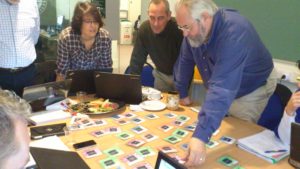 How do you go about developing an online course?
How do you go about developing an online course?
As with any formal guided learning path, the starting point should always be the learning outcomes. What will your students be able to do as a result of the course?
There are many ways of determining how outcomes will be met. Here are four:
1. In the M-House project we used the concept of Key Learning situations. The course is targeted at home-based adults wanting to move on either into work or into business. The aim of the course is to raise awareness of how certain household skills can transfer to the world of work. Because of this, it is especially important to make the link between experience and learning very close. The way we chose to do this was by identifying a series of key situations which we thought all adults with experience of running a household would have and then to turn these into our Key Learning Situations (KLS). These KLSs would then form the starting point for the entrepreneurial skill to be highlighted whether that was in the area of financial recording, IT use, major purchases or solving conflicts.
2. In the FLITE project we used an adapted engineering process, ConCurrent Design to ensure that all the stakeholders were able to influence the final outcome. By including ALL stakeholders in the course design process we were able to overcome the problem of a course designed by trainers but not tailored to the end users. In this case the target learners included IT workers already in jobs and final year or masters ICT students who would benefit from the real world experience of the business employees. By involving stakeholders in the whole process of design, rather than just at the beginning when a needs analysis is being performed, the final version of the course was much closer to the needs of the final users. The end result of the carefully structured ConCurrent Design process is a design document which is then used to create the live version of the course.
You can learn more about how the two courses were designed in this 30 minute presentation at the 2014 Global Ed Conference.
Global Ed Con recording & Slideshare ppt.
3. In Campus NooA there is a hybrid approach offering individualised timetables along a common learning pathway. The idea of cooperative freedom is that the social learning can still take place with course colleagues who are all at different stages of the course. This promotes peer learning, mentoring and review. It does require careful planning though as it is difficult to include group exercises if everyone is at a different stage.

4. The UK’s Open University has developed a series of design tools under the title of OULDI, which helps with designing whole courses. Grainne Conole has been very active in testing and disseminating how to use the various tools, for example here with a blog post on how to run a learning design workshop. The image at the top of this blog post shows the FLITE project choosing which aspects of the course we thought were most important, one of the suggested activities of the 7Cs of Learning Design Approach developed by OULDI.
Learning Trajectory
An important consideration is to map out a trajectory in terms of optimal order for achieving the outcomes. In both the M-House project and the FLITE project we experimented with trajectory. In M-House, we offered 3 rounds of concurrent modules while in the FLITE project we took a more start-up oriented approach whereby, the content to be learned was available on a just in time basis with tutor support offered on a limited consultancy time basis in order to achieve the overall goal which was to produce a group business plan as a result of going through the concurrent design process..
Conclusions:
- (Online) Learning can be messy and non-linear.
- There are several ways of planning an (online) course.
- There are tools and processes to help you.